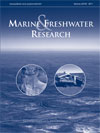
Marine and Freshwater Research
Volume 62 Number 10 2011
MF11021 Continuous recruitment underpins fish persistence in the arid rivers of far-western Queensland, Australia
MF11075 Seasonal variability in faecal bacteria of semiarid rivers in the Serengeti National Park, Tanzania
MF11056 Sedimentation effects on the benthos of streams and estuaries: a cross-ecosystem comparison
Sensitivities of benthic communities to stressors likely differ in streams and estuaries, owing to differences in the physical environment and ecosystem function. We compared effects of a common stressor by simultaneously applying deposited sediment to plots in both of these systems. Estuarine communities were more sensitive to short-term sedimentation than those in streams. These results demonstrate the response to a common stressor can vary in linked aquatic ecosystems.
MF11013 Rapid increase in coral cover on an isolated coral reef, the Ashmore Reef National Nature Reserve, north-western Australia
Offshore coral reef ecosystems may be buffered from anthropogenic disturbances, but recovery may be slowed by isolation. Changes in coral cover and community composition were measured from 2005 to 2009, and revealed a tripling of hard coral cover, a doubling of soft coral cover, and taxonomic shifts. Coral recovery in isolated locations can occur rapidly through the interacting effects of successful self-recruitment and reduced exposure to coastal pollution.
MF11053 Variation in mussel and barnacle recruitment parallels a shift in intertidal community structure in the Cook Strait region of New Zealand
Researchers are increasingly turning to larger scales to understand the role of recruitment variation in structuring marine communities. We found that species-specific recruitment patterns play a role in maintaining different invertebrate assemblages in adjacent locations in New Zealand (harbour and open coast). This study shows that the sharp boundaries often found in bay–open coast systems can be maintained at least in part by differential recruitment.
MF11140 Learned recognition and avoidance of invasive mosquitofish by the shrimp, Paratya australiensis
Invasive pest fish having negative impacts on a wide range of native aquatic animals. While some research has examined their interactions with native fish, very little research has examined their impact on shrimp. Here we show that naïve shrimp learn to recognise Gambusia as a threat and alter their behaviour to reduce the risk of predation by becoming nocturnal.
MF11082 Reviewing hook degradation to promote ejection after ingestion by marine fish
This research was initiated in response to a need to understand the key factors affecting hook oxidation, so that their decay can be improved after being swallowed by unwanted fish. Hook degradation was mostly influenced by the wire material and diameter, and could be promoted by choosing thin carbon steel designs, preferably with so-called ‘bait-holder barbs’ along the shaft. By rapidly oxidising and weakening, such designs could help to reduce the impacts of hooks on released fish.
MF10298Feeding-preference trials confirm unexpected stable isotope analysis results: freshwater macroinvertebrates do consume macrophytes
Several studies suggest that aquatic plants are unimportant in freshwater invertebrate diets, but stable isotope analyses showed that they were a major food source in a Tasmanian river. Feeding trials confirmed that the invertebrates preferred the aquatic plant Triglochin procerum to eucalypt or acacia leaves. The importance of aquatic plants to the food web may be underestimated, because herbivory can be disguised by their rapid growth.



